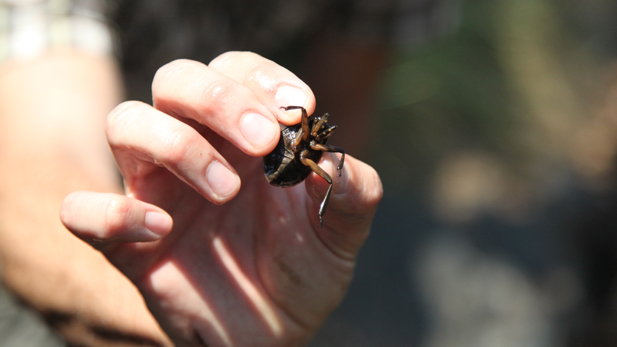The trees along the Chiricahua Mountain slopes in Coronado National Forest, the ones not devastated by raging wildfires, look parched. The air is hot and dry, and depending on which way the wind blows, it’s either slightly smoky or very smoky.
In the wake of Arizona’s still-raging wildfires, the national forest has been closed off to the public. But Kate Boersma and three field assistants gained special access to East Turkey Creek, an area west of Portal near the New Mexico border.
“This is our first access since the Horseshoe Two fire went through, so we’re excited to get some samples,” she says.
Boersma is a doctoral student at Oregon State University who studies aquatic insects. She’s here to survey the creek before the summer rains wash tons of ash into the mountain streams, changing the streams’ ecology. She and her field assistants pick a 100-meter stretch of stream relatively free of ash deposits.
Then they count and measure the pools and areas of running water called riffles. She’ll compare the data sets with those collected by her colleague over the past eight years.
“A lot of the predicted effects of fire have to do with the morphology of the stream, the shape, and how much sediment is there,” she says. “So we’re predicting that following the monsoon season, all of this ash that’s higher up in the canyon will be transported down and may fill (it) in, may affect the water quality.”
Boersma wades in to the creek to measure physical dimensions of the stream and record what kind of sediment – if any – is at the bottom.
Then she uses a fine mesh hand net to dredge up pebbles, decomposing leaves, and aquatic insects from the pool. They’re taking a kind of bug census.
In this pool, the top predator is not a fish or a frog – it’s an insect. She pulls up a giant water bug, an air-breather. It’s about an inch and a half long.
“It eats fish, it eats amphibians, it eats other insects,” Boersma says. “It catches onto its prey using its raptorial forelimbs, and then it inserts that beak, and it actually inserts digestive juices inside its prey, digests them from the inside, and then slurps up the digested remains.”
 The giant water bug, a top predator that can eat frogs and fish, serves as an indicator of stream health.
The giant water bug, a top predator that can eat frogs and fish, serves as an indicator of stream health.After they separate the bugs from the detritus and rinse them, they drop them into jars of ethanol. Some of the bugs they can identify in the field, but most will need to be identified under a microscope.
The Environmental Protection Agency and other environmental agencies use data on aquatic insects to study stream health. But in drier regions, like the Southwest, they can also use the data to study stream permanence.
“There are these types of insects that either require permanent water or don’t, or require certain degrees of permanence,” she said. “So we can use that information to talk about hydrology in a way that’s really hard to sample.”
Boersma and her colleagues are finished for now. But they’ll be back to East Turkey Creek after the monsoons, measuring, counting and cataloging.

By submitting your comments, you hereby give AZPM the right to post your comments and potentially use them in any other form of media operated by this institution.